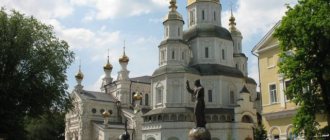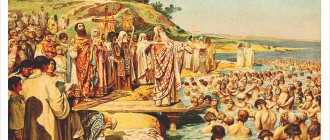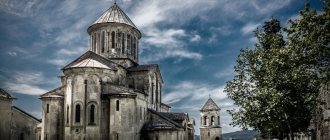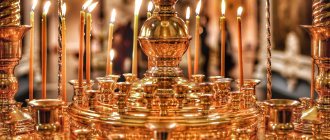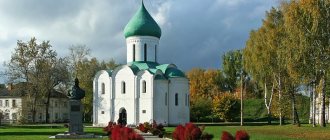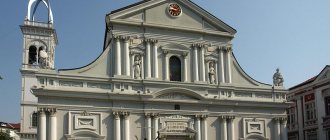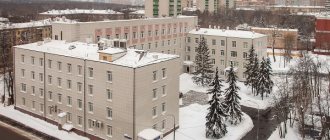In the history of Orthodoxy in the lands of Ukraine, which is replete with dramatic pages, a special place is occupied by schisms and discord caused by the sin of phyletheism, that is, attempts to replace the canonical saving mission of the Church of Christ with vain worldly political and “social” life in a religious shell, that is, actions that ultimately entail bitterness and bloodshed in both religious and secular life. It is significant that the actions of those who in the recent past tore apart the Church as the living body of Christ were either directly inspired by the atheistic authorities (primarily the state security agencies of the USSR), or were willingly “adopted” by the latter and inflated.
In this regard, the example of the Ukrainian Autocephalous Orthodox Church is very indicative, whose “self-sanctified” ministers in the 1920s. willingly became in the hands of the security officers the main battering ram against canonical Orthodoxy in Ukraine[1]. Most of them, “bypassing the need” for the atheistic state, ended up in execution chambers. Their legal rehabilitation took place. The trouble is that, according to St. John Chrysostom, the sin of schism cannot be washed away even by the blood of martyrdom...
Who needs a united Ukrainian church and why?
The church in Ukraine is separated from the state, but this issue is primarily political. Especially considering that the Ukrainian Church of the “Moscow Patriarchate” was essentially a division of the Russian Church.
On the other hand, as an expert on religious issues, former clergyman Roman Melnichenko , for church people who somehow use church services, this is an important decision. For example, there were often cases when clergy of different Orthodox denominations did not recognize each other’s rituals, considering “not their own” baptism or funeral service for the deceased “wrong.” After the Ukrainian Church became united and canonical, the fear that someone was baptized or buried somehow “wrongly” simply has no basis.
UAOC during the Soviet period
Until the mid-1920s, the Soviet authorities supported the development of the UAOC, hoping in this way to weaken the Russian Orthodox Church, led by Patriarch Tikhon. However, since 1929, Soviet intelligence services began mass arrests of autocephalists. In 1930, the UAOC announced its self-dissolution. In 1942, on the territory of Ukraine, which was under German occupation, the activities of the UAOC were restored. However, after the retreat of German troops, representatives of the UAOC emigrated and founded their dioceses in places where the Ukrainian diaspora was densely populated, primarily in the USA and Canada.
In 1989, the restoration of the activities of the UAOC in Ukraine was again officially proclaimed in Lvov. In 1990, the so-called a local council of a religious organization, its charter was adopted, and Symon Petliura’s nephew “Metropolitan” Mstislav Skrypnyk, who returned from emigration to the United States, was proclaimed “Patriarch of Kyiv and all Ukraine.” Currently, the UAOC is headed by “Metropolitan” Macarius Maletich.
The situation with current clergy
For the clergy of the Kyiv Patriarchate, a single church is a great joy. The Kiev Patriarchate received canonical status, which means that all their sacraments, all their clergy are legal and blessed. Therefore, everything will remain as it was, explained Roman Melnichenko. There is no need to re-register anything, no additional procedures. It’s just that the entire structure of the Kyiv Patriarchate will become recognized by the Orthodox world.
As for supporters of the MP, conflicts still occur.
Severance of relations between the Russian Orthodox Church and Constantinople
On October 15, 2022, the Synod of the Russian Orthodox Church decided to sever Eucharistic communion with the Patriarchate of Constantinople. According to the statement of the Russian Orthodox Church, “an encroachment on other people’s canonical inheritances, an attempt to renounce one’s own historical decisions and obligations, takes the Patriarchate of Constantinople beyond the canonical field.” From October 15, it is impossible for all clergy of the Russian Orthodox Church to jointly participate in divine services with clergy of the Church of Constantinople, and for laity to participate in the sacraments performed in its churches.
The Synod statement said that Constantinople, in its actions, refers to the non-existent “canonical privileges of the Patriarch of Constantinople to accept appeals from bishops from all autocephalous Churches.” The assignment by Constantinople of the authority to cancel the decisions of other local Orthodox churches is considered by the Russian Orthodox Church as a manifestation of a false teaching (heresy), ascribing to the patriarch the rights of “first without equal (primus sine paribus) with universal jurisdiction.”
An attempt by Constantinople to repeal the act of 1686 on the transfer of the Kyiv Metropolis to the jurisdiction of the Russian Church was declared illegal by the Russian Orthodox Church. The Synodal Charter of 1686 and other documents accompanying it say nothing about their temporary nature or that this act can be canceled. In addition, the Synod of the Russian Orthodox Church indicated that the canonical territory of the Kyiv Metropolis of 1686 is significantly smaller than the canonical territory of the modern Ukrainian Orthodox Church, most of whose dioceses were founded and developed within the Russian Church.
On November 11, the Council of Bishops of the UOC declared that the decisions of the Patriarchate of Constantinople of October 11, 2022 are invalid and have “no canonical force.”
Scandals and Filaret
The head of the UOC-KP Filaret at first actively advocated the creation of the OCU. However, soon after the creation of the church, Filaret suddenly disagreed with the statutes of the OCU and accused Metropolitan Epiphany of violating the agreements.
In December 2022, Filaret said that Epiphanius submitted to the Patriarch of Constantinople, allegedly dividing the one big church - in particular, the Kiev Patriarchate.
Epiphany himself believes that there are pro-Russian forces behind Filaret, but he may not realize this. Thus, the Kremlin is using Filaret in the fight against the independent Ukrainian church.
Watch a video about the history of the Orthodox Church in the world:
Years of the Civil War 1917-1922
The first attempts to create an autocephalous church were made in Ukraine during the collapse of Russian statehood after the February and October revolutions of 1917. With the support of the self-proclaimed Ukrainian Central Rada, in the summer of 1917, a group of Orthodox priests and laity took the initiative to hold an All-Ukrainian Church Council, create an autocephalous church and Ukrainianize worship. The leader of the movement was Archpriest Vasily Lipkovsky, who was soon deprived of his priesthood for schismatic activities.
The activities of supporters of autocephaly met with resistance from most of the clergy and believers of Ukraine. On the initiative of Archbishop Evlogiy (Georgievsky) of Volyn, an All-Ukrainian Church Council was held in Kyiv in January 1918, the majority of the delegates of which opposed the establishment of an autocephalous Orthodox Church in Ukraine.
On January 1, 1919, the directory of the Ukrainian People's Republic adopted the law “On the autocephaly of the Ukrainian Orthodox Church and its supreme government.” Through their ambassador to Turkey, the Ukrainian authorities tried to achieve recognition of the self-proclaimed church by the Patriarchate of Constantinople, but were unsuccessful.
Later, with the support of the Bolsheviks, the first Ukrainian parishes of Lipkovsky’s supporters were registered in the Ukrainian SSR. The Russian Orthodox Church (since 1943 - the Russian Orthodox Church, ROC), led by Patriarch Tikhon (Belavin), considered the actions of the autocephalists in Ukraine as a schism.
On May 5, 1920, activists of the Ukrainian nationalist movement proclaimed the “Ukrainian Autocephalous Orthodox Church” (UAOC). None of the Orthodox bishops took part in making this decision. On October 14, 1921, supporters of the UAOC convened the so-called. All-Ukrainian Orthodox Church Council, the participants of which were only 64 priests and 17 deacons. The Patriarchal Exarch of Ukraine, Metropolitan Mikhail (Ermakov), refused to attend this meeting. Rejecting the candidates proposed by Ukrainian nationalists, he declared that he would not ordain “vipers as bishops.” As a result, the Ukrainian “bishops” were elevated to the rank in violation of canonical rules, in particular Vasily Lipkovsky himself “dedicated” himself to the highest church rank (according to church canons, only two other bishops can do this). The UAOC was not recognized by any of the canonical Orthodox churches.
The question of the autocephalous church in Ukraine - history and politics
The issue of granting a tomos of autocephaly has been one of the most discussed in Ukraine for several months now. There is reason to believe that the autocephaly project is not being implemented without a geopolitical component. Ultimately, this is a project to minimize the mental and spiritual influence of Russia in Ukraine and the post-Soviet space as a whole. Everything that happens today with the church in Ukraine has not just canonical, but also political significance. Decisions are made, naturally, not without the influence of external factors, but this influence should not be exaggerated and considered exceptional. At the same time, it would be naive to believe that Bartholomew acts on his own initiative. Doctor of the Department of Post-Soviet Abroad Countries of the Russian State University for the Humanities, RIAC expert Alexander Gushchin spoke about the historical background of the dispute between Orthodox churches on the territory of Ukraine.
— The issue of granting a tomos of autocephaly has been one of the most discussed in Ukraine for several months now. What are the historical background of this dispute?
Alexander Kramarenko: Autocephaly for Ukraine: geopoliticization of church affairs
After the union of 1438, Patriarch Joseph of Constantinople and almost the entire Greek Church recognized the primacy of Pope Eugene - this step was necessary to receive military and political assistance from the Catholic West in the fight against the Ottomans, who occupied almost everything Balkans, Middle East and North Africa. After Constantinople fell away from Orthodoxy for several years (1439–1453) as a result of the Ferraro-Florentine Union, when Constantinople signed a union with the Roman Catholic Church, in 1448 the Moscow Metropolis became autocephalous, receiving the status of a patriarchate (1589). It should be noted that this is an independent decision of the mid-15th century. is completely legal and justified due to the fact that the kyriarchal church has fallen into heresy.
On the territory of Ukraine by the end of the 16th century. Several Orthodox jurisdictions were formed at once - Volyn, Galicia, Podolia, Chernihiv region were under the jurisdiction of the Kyiv Metropolis of the Patriarchate of Constantinople. Slobozhanshchina was under the jurisdiction of the Moscow Patriarchate, Bukovina was part of the Radovets diocese, which in 1781 became part of the Serbian Orthodox Church. After the occupation of Bukovina in 1918–1919. By Romania, the Bukovinian Metropolis became part of the Romanian Orthodox Church, and after the annexation of Bukovina to the Ukrainian SSR - part of the Ukrainian Exarchate of the Russian Orthodox Church. In the 1920s–1930s. churches in Volhynia and Galicia were under the jurisdiction of the Polish Autocephalous Orthodox Church.
The Kiev Metropolis, after the war of the Polish-Lithuanian Commonwealth with Russia (1654–1667) in 1686, was transferred by Constantinople to the subordination of the Moscow Patriarchate. Submission to the Moscow Patriarch in 1685 was carried out first without the permission of Constantinople, by the authority of the Russian sovereigns. The Russian authorities first requested the Kyiv metropolitanate in 1684, but Patriarch Jacob refused. Then, on July 8, 1685, in the St. Sophia Cathedral in Kyiv, despite the resistance of part of the clergy, Bishop Gideon of Lutsk was elected metropolitan. Then he was elevated by the Moscow Patriarch to the rank of Metropolitan of Kyiv in the Moscow Cathedral. After this, an embassy was sent to Istanbul, which in the summer of 1686 negotiated with the Patriarch of Jerusalem Dositheos and the Ecumenical Patriarch Dionysius, and the latter gave his consent. As a result, Metropolitan Gideon was confirmed as the head of the Kyiv Metropolis, united with the Moscow Patriarchate. All this was done not without the help of the Turkish authorities and not without stimulation, as they would say today, but then many issues were resolved in this way, and the fact remains that the tsarist diplomats obtained from Patriarch Dionysius consent to transfer the Kiev Metropolis under the patronage of the Patriarch of Moscow. Nevertheless, subsequently the Ecumenical Patriarchate repeatedly noted a violation of the canonical order, which was, for example, included in the tomos recognizing the Orthodox Church in Poland as autocephalous in 1924.
However, there was no official refutation of the tomos in 1686. In addition, it is important to pay attention to the fact that while St. Petersburg was strong, Constantinople did not show itself during the synodal period, but during periods of unrest - the civil war in Russia, instability in modern Ukraine - Constantinople was active, sought and seeks to undermine the influence of the Russian Orthodox Church . The point is that he considers the act of 1686 not as a complete transfer of jurisdiction, but only a transfer of the right of consecration and something like a concession according to the principle - “if I want, I give, but if I want, I take.” The Russian Orthodox Church, saying that it is the mother church in relation to the UOC, emphasizes that the primacy of the honor of the Patriarchs of Constantinople cannot be the primacy of power. Moreover, the desire to be guided not only by the principle of the primacy of honor, but also of power is considered a manifestation of papism, which is unacceptable for Orthodoxy, which consists of 14 (according to the Russian diptych - 15) Orthodox churches. Based on this, even the appointment of two exarchs of the Patriarch of Constantinople to Ukraine is perceived as a violation, not to mention the fact that the granting of autocephaly should be carried out by the kyriarchal church.
There is reason to believe that the autocephaly project is not being implemented without a geopolitical component. Ultimately, this is a project to minimize the mental and spiritual influence of Russia in Ukraine and the post-Soviet space as a whole.
— How could you characterize the political significance of this process, how important is it during the election campaign and what impact can it have on it?
It is worth noting that the issue of autocephaly has been around for quite some time - it was discussed during the presidency of V. Yushchenko, but then the matter did not go beyond intentions. Now this issue is truly one of the most pressing in modern Ukraine. If we talk about its political significance, I would note that politics plays a predominant role in all discussions, and only then purely canonical disputes. Naturally, when the President of Ukraine proclaims the triad “language, army, faith” as the basic principles of his course and election campaign, it is not surprising that so much attention is paid to the development of the Ukrainian church.
It is also interesting that this attention is growing more and more and is essentially a violation of Art. 35 of the Constitution of Ukraine, which deals with the separation of church and state. But the authorities do not pay attention to this, since political expediency dictates the need to politicize the church issue. One should not be naive and, following some observers or representatives of the clergy, lament the fact that politics has such a strong influence on church issues - this has been the case at all times. The question is rather whether certain decisions contribute to the resolution of conflicts and the establishment of peace, overcoming the lines of division in Ukrainian society. And it is precisely in this context that quite serious questions arise regarding the activities of ardent supporters of obtaining autocephaly. In conditions when the Ukrainian president and executive power as a whole do not have any successes in the field of socio-economic development, when only a visa-free regime with the EU can be presented as a fully fulfilled promise, the tomos of autocephaly remains an argument that, if received, can add the president gets a few percent of the votes. This is unlikely to have a decisive influence - after all, the issues of peace and social upheaval are more important for modern Ukrainian society, but the question of the future of the Ukrainian church is also quite important, so its positive solution could become an important part of P. Poroshenko’s election campaign.
Alexander Gushchin: The start of the election campaign in Ukraine is the beginning of a turbulent political year
It is also noteworthy that Petro Poroshenko made a miscalculation regarding the fact that the tomos would be granted by Patriarch Bartholomew of Constantinople to celebrate the 1030th anniversary of the baptism of Rus'. Now specific deadlines have not been set, but the current president is doing everything to get the tomos before the first round of elections. Both experts and representatives of the clergy, who have been talking about the impossibility of receiving a tomos all the time, citing the non-canonical nature of this act of Constantinople, also turned out to be not entirely right. Events have shown that the Phanar is ready to go far in its desire to remove the Ukrainian Church from the subordination of the Russian Orthodox Church, and in this context one should consider the appointment to Ukraine of two exarchs of Patriarch Bartholomew - Archbishop of Pamphylia from the western diocese of the Ukrainian Orthodox Church (UOC) in the USA of the Patriarchate of Constantinople Daniel and Bishop Edmonton from the western diocese of the UOC in Canada Hilarion. They are actually preparing to provide a tomos in Ukraine, while violating the canonical jurisdiction of the Russian Orthodox Church, to which Constantinople, by a surprising coincidence, has recently had questions.
— How would you characterize the current situation?
It is quite obvious that the process of preparation for the granting of autocephaly reached a new level after the Patriarch of Constantinople sent his exarchs to Ukraine. First of all, it is worth noting that this is not a mission aimed at eliminating the conflict - it is an attempt to “stake out” canonical territory for oneself, to prepare the necessary solution
However, it is impossible to assume that the tomos will be provided to existing churches. Of course, many in the UOC-KP would like just such a scenario, especially “patriarch” Filaret himself. In this regard, attention is drawn to the fact of Filaret’s activity, who last week visited the United States, the State Department, and even spoke at the Atlantic Council. There he made a statement that autocephaly could be granted at the session of the Synod of the Church of Constantinople in October.
However, Filaret's calculations seem too optimistic. Firstly, he leads a schismatic church. Of course, theoretically, it can be assumed that two priests from overseas can carry out the consecration and reordination of schismatics, but still, in terms of image, this will not be very beneficial for Constantinople. In principle, according to the logic of Constantinople, if the act of transferring the Ukrainian church to the bosom of Moscow in the 17th century is denied, then it is theoretically possible to regard excommunication as ineffective, but this will lead to a serious conflict. This is a step towards open confrontation, and also risks conflict with a number of local churches. In addition, it should be borne in mind that the figure of Filaret himself is very controversial. It raises questions not only among the Russian Orthodox Church or the UOC-MP, but even among many supporters of autocephaly. Filaret's activities in 1990, his harsh and authoritarian character, and intransigence are to some extent an obstacle for Constantinople.
Still, the issues of peace and social upheaval are more important for modern Ukrainian society, but the question of the future of the Ukrainian church is also quite important, so its positive solution can become an important part of P. Poroshenko’s election campaign.
In reality, we can talk about a more likely scenario - the creation of a parallel structure to the UOC-MP, which would consist of the UAOC, the UOC-KP and the autocephalist-minded part of the UP-MP, ready to move into the fold of the new autocephalous church. Such a part really exists, and more than a third of the parishes in the event of the creation of autocephaly could go into it, but a significant part of its representatives are negatively disposed towards Filaret personally and will never agree to his patriarchate in the new church.
Theoretically, the option of an exarchate would be more beneficial for Constantinople, which could be declared a transitional form and at that time become equal in level of influence with the Russian Orthodox Church, but this option, beneficial to Bartholomew, is unlikely to suit his overseas patrons and will not be accepted in Kyiv. P. Poroshenko, naturally, benefits from the way of granting autocephaly right away - any other forms such as an exarchate will raise questions and will need to be explained in a more complex manner.
In any scenario for the development of events with the status of the UOC, the new structure created under the control of Constantinople will need to elect a patriarch. In addition to Filaret, who is unlikely to have a chance, the names of the representative of the Constantinople Patriarchate at the World Council of Churches, Archbishop Job of Telmis, and Metropolitan Simeon of Vinnitsa and Bar from the UOC MP are mentioned.
Alexander Gushchin: Autocephaly through Tomos is another line of division in Ukrainian society
Thus, the creation by Constantinople of an autocephalous church in Ukraine could lead to the implementation of the so-called Estonian scenario - there will be parallel jurisdictions, that is, a split will remain, but the part oriented towards Moscow will be smaller than it is now, and will probably lose, from Kiev’s point of view, the opportunity to be called as it is called today, as P. Poroshenko has already announced. So there can be no talk of overcoming the schism, not to mention the fact that the risk of clashes over property, over the parishes themselves, and even laurels increases sharply.
— Do you see any geopolitical aspects of the creation of autocephaly in Ukraine by Constantinople?
There is reason to believe that the autocephaly project is not being implemented without a geopolitical component. Ultimately, this is a project to minimize the mental and spiritual influence of Russia in Ukraine and the post-Soviet space as a whole. I would not like to engage in conspiracy theories, but it is clear to me that the project is supervised not only and not so much by Bartholomew. It rather acts as a battering ram. Filaret's recent trips and the arrival of priests from the USA and Canada only confirm this. An attempt is being made to reform Orthodoxy and give it a certain modern type, and this in the future may affect not only Ukraine. Work is underway to persuade a number of local churches to support Constantinople, and a struggle is unfolding for influence on the position of authorities.
For example, in the issue we are discussing, the position of the Athos monasteries on canonical issues is important. If the majority of them openly advocate for one or another scenario, this could have a fairly significant impact. Recently, a whole campaign has been carried out to discredit a number of monasteries. It is accompanied by accusations of connections with Russia, including corruption, and an aggravation of the visa issue. Obviously, these problems are being exaggerated in order to discredit the possible opinion of a number of monasteries in support of the Russian Orthodox Church. And this despite the fact that a significant part of the authoritative figures of world Orthodoxy - for example, Patriarch Theodore - oppose the split of the UOC through unauthorized autocephaly. Recently, unfortunately, a lot of things have been done that violate the principles. For example, it is questioned that the church is built on a territorial basis, and not on a national basis, a typical example of which is the position of the Russian Orthodox Church regarding the Abkhaz and Ossetian churches. The fact that phyletism is a heresy and a schism also comes into question. At the same time, the Patriarchate of Constantinople, by its decision, allows remarriage in the event of the widowhood of a priest or in the event that the mother herself leaves her husband-priest.
Everything that happens today with the church in Ukraine has not just canonical, but also political significance. Decisions are made, naturally, not without the influence of external factors, but this influence should not be exaggerated and considered exceptional. At the same time, it would be naive to believe that Bartholomew acts on his own initiative.
Positive consequences
According to leading researcher and head of the Center for the Study of Problems of Religion and Society at the Institute of Europe of the Russian Academy of Sciences, religious scholar Roman Lunkin, the gap also has positive consequences. “The OCU, recognized by Patriarch Bartholomew, found itself in an even more confusing canonical position - under President Vladimir Zelensky, this church was left without the help of the authorities, did not completely separate from the Kyiv Patriarchate, and how ready it is to integrate with the Phanar remains unclear,” Lunkin believes.
This decision, he believes, also became support for the clergy and believers of the canonical Ukrainian Orthodox Church (UOC). “The absence of such support from the Russian Orthodox Church would be a betrayal of the interests of the UOC, which was left alone with nationalists and crazy politicians. And this would be the beginning of the end of the UOC. So it’s very good that the stubborn Patriarch Bartholomew did not leave any ground for games of church diplomacy,” the expert added.
In his opinion, in the context of the breakdown in relations between the Moscow and Constantinople Patriarchates, an important historical step was the accession to the Russian Orthodox Church of most of the Archdiocese of parishes of the Russian tradition in Western Europe.
The future is uncertain
Historical polemics about canons may hide long-standing political interests, says Alexei Makarkin, first vice-president of the Center for Political Analysis. “Moscow and Constantinople are long-time competitors, and during the twentieth century they exchanged various moves, <...> not very friendly. For example, <…> in Estonia there are now two parallel jurisdictions, there is Moscow and there is Constantinople. <…> The competition between the two churches is long-lasting,” he told TASS.
Makarkin believes that the break with Constantinople was necessary not only on canonical grounds. “The Ukrainian Orthodox Church of the Moscow Patriarchate <...> autocephaly was perceived sharply negatively - with protesting believers, a significant part of the clergy and episcopate, the most faithful and devoted. <…> It was possible to give in, but this concession would be regarded as an admission of defeat and would entail the growth of autocephalist sentiments in other parts of the Moscow Patriarchate, for example in the Belarusian Orthodox Church; now these sentiments are very weak, although they already exist. <…> If Moscow <…> went to meet strangers halfway, its own people would feel betrayed and abandoned,” he said.
In his opinion, the break with Constantinople was intended to remind local churches of the seriousness of the problem of the Ukrainian schism. “Moscow hoped that by making a break with Constantinople, it would prevent recognition of the OCU by other churches. In political terms, she has sharply raised the stakes: we are determined and serious,” Makarkin believes.
However, decisive actions, the political scientist said, could lead the Russian Orthodox Church to a dead end. “Now the Moscow Patriarchate faces a difficult decision - what to do next? According to the logic of further events, it is necessary to refuse recognition of the Greek Church. <…> The story with the Greek Church may trigger the process of recognition, exchanges of blows will continue, and it is unlikely that it will be possible to resolve relations with Constantinople in the foreseeable future,” he concluded.


